It was a grey, damp Boxing day morning 2021 in England and the very sad news arrived of the death at age 90 of Archbishop Desmond Mpilo Tutu earlier that morning in Cape Town after a full and active life of great moral conviction and compassion for humanity. Online messaging technology, not available at the time of his enthronement in 1986 as Archbishop of Cape Town, meant I swiftly received the news from my sister who lives in Cape Town. I shed tears of sadness for his grieving family and the loss to the world of a person whose courage, tenacity, love and humour helped change a nation for the better, influencing many around the world to stand for justice, truth, reconciliation and peace.
What follows are my recollections of meeting and being in the presence of Archbishop Desmond Tutu at his beloved St George’s Cathedral, Cape Town.
Context
I grew up in the St George’s Cathedral community in Cape Town in the 1970s and 1980s. The congregation was a mix of white, black and mixed race people (known at the time as Cape Coloureds) and was spiritually led by the Dean of Cape Town, Edward Laurie King (whom we all referred to as Dean Ted King or Fr. Ted King). My father, John Herbert, was one of the Churchwardens, my mother Wendy sang in the morning choir, my elder brothers were choristers until their voices broke (mostly for Evensong, festival occasions and the Nine Lessons & Carols at Christmas) and my younger sister and I were altar servers, usually carrying a candle or crucifix in the processions and helping the priests with preparing the Eucharist.
Enthroning our new Archbishop
Apparently there were over 1,300 people at the enthronement in the Cathedral.The announcement in 1986 that the new Archbishop of Cape Town would be the Bishop of Johannesburg the Right Reverend Desmond Tutu (+Desmond – see footnote) threw the Cathedral community into a flurry of preparations. Previous enthronements had always been big, solemn celebrations sometimes attended by priests from around the world. However this was South Africa’s first black Archbishop of Cape Town with the country still in the grip of apartheid, so the eyes of the world were upon us, and more bishops from around the world than ever before were invited to attend. According to the newspapers, 56 bishops and many other clergy, plus representatives from other religions, came. Visiting clergy included The Most Reverend Robert Runcie (Archbishop of Canterbury). Several famous people from around the world attended, including Coretta Scott King (wife of the late Martin Luther King), Stevie Wonder, Harry Belafonte and Senator Edward Kennedy. The South African government of the time blocked visas for some of the invited guests, such as Bishop Ding from China, whose visa was withdrawn just before he was due to travel. Apparently there were over 1,300 people at the enthronement in the Cathedral. Cape Town was represented officially by the Mayor and Mayoress Leon and Anthula Markovitz and their deputies Peter and Clara Muller.
The logistics of finding accommodation for and transporting all those visitors was resolved by the enthronement organising team asking parishioners willing to host visitors for a few days to turn up at Cape Town International airport and take an enthronement guest home with them as the flights arrived. Our family offered a bed for a Bishop, and Bishop Amos Waiaru, a Bishop of the Solomon Islands, was assigned to us when we arrived at the airport on Friday 5 September (in 1988 Bishop Amos became Archbishop of the Solomon Islands – Archbishop of Melanesia). He spoke a form of English which had evolved in the islands from several languages, called Pijin English, and told us a bit about life and the Anglican church there.
The following morning while my father was at the airport helping receive and allocate Enthronement guests, a man arrived from England who explained that +Desmond had invited him to come (his son was +Desmond’s godson, from the time our soon to be Archbishop was assistant curate at St Mary’s Church, Bletchingley in England while he was doing his Masters) but somehow his name wasn’t on the list so he didn’t have a place to stay. Dad brought John Ewington home, my sister moved into my old bottom bunk bed so he could have her bedroom while I moved back to the top bunk, while Bishop Amos used my new bedroom. Hosting John Ewington in our home was to have far reaching good consequences for me. He was an organist and the General Secretary of the Guild of Church Musicians so he had a lot of musical church connections in England.
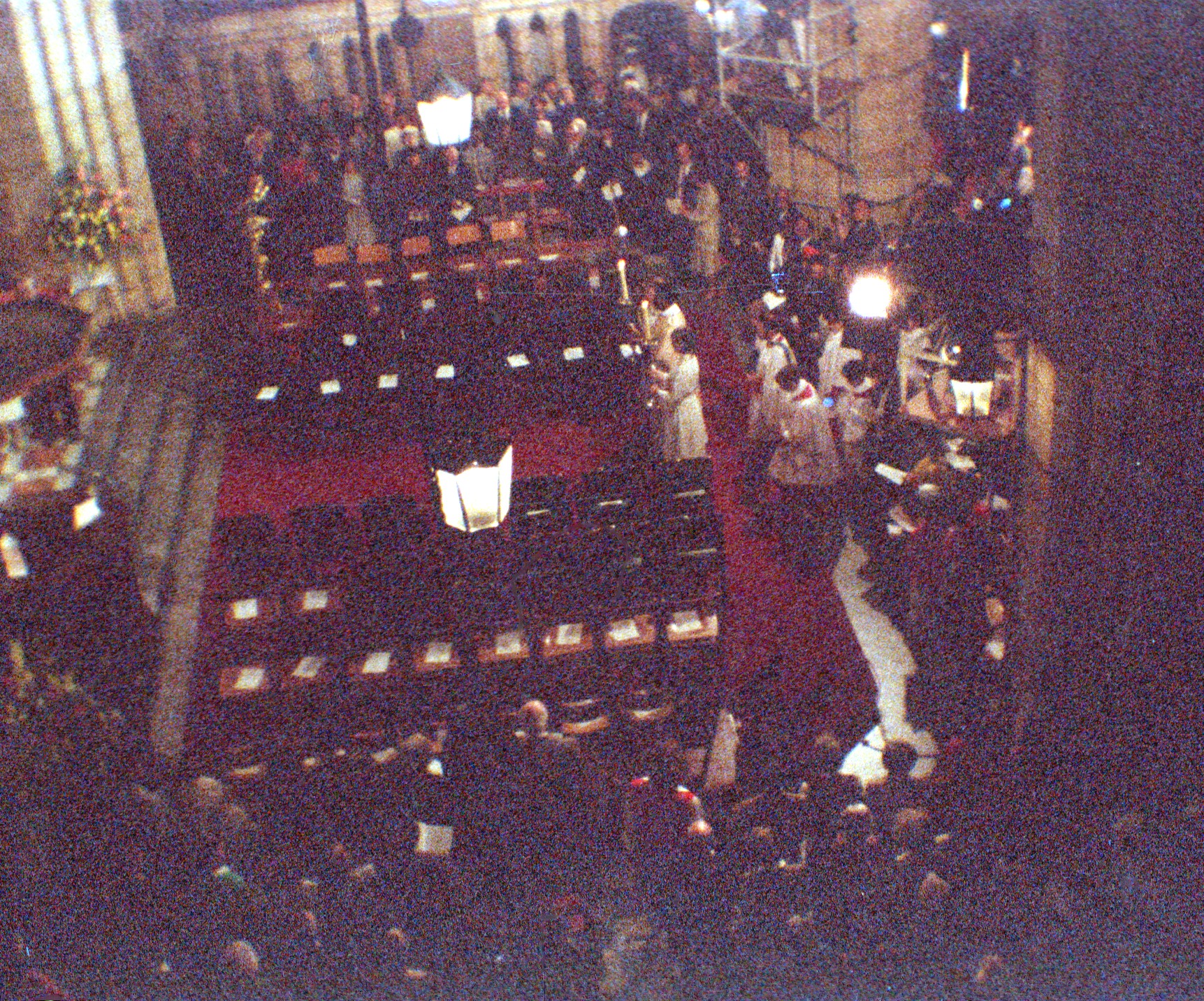 Servers (Petra, Edward and Anna) leading the choir procession onto the red platform
Servers (Petra, Edward and Anna) leading the choir procession onto the red platform
Two serving teams were needed for the Enthronement (one to lead the choir and another for the main procession leading the priests) and I was picked to carry a candle in the processions at the start and end of the service. My sister wasn’t selected for the processions but was able to attend. She used my 110mm camera to take a few photos from the gallery just below the great north transcept window, they are very grainy but I’m so glad she was able to take them as it showed how full the Cathedral was.
There was a 2-hour rehearsal during the afternoon for servers and choirs in the Cathedral on Saturday 6 September. Dean King described this occasion: “the final dress rehearsal in September 1986 found me in the pulpit trying to get order out of a vast mitred and garrulous ecclesiastical family, amidst which, mercifully, three Japanese Archbishops and four Orthodox Arhimandrites sat in total silence” (King, 1996).
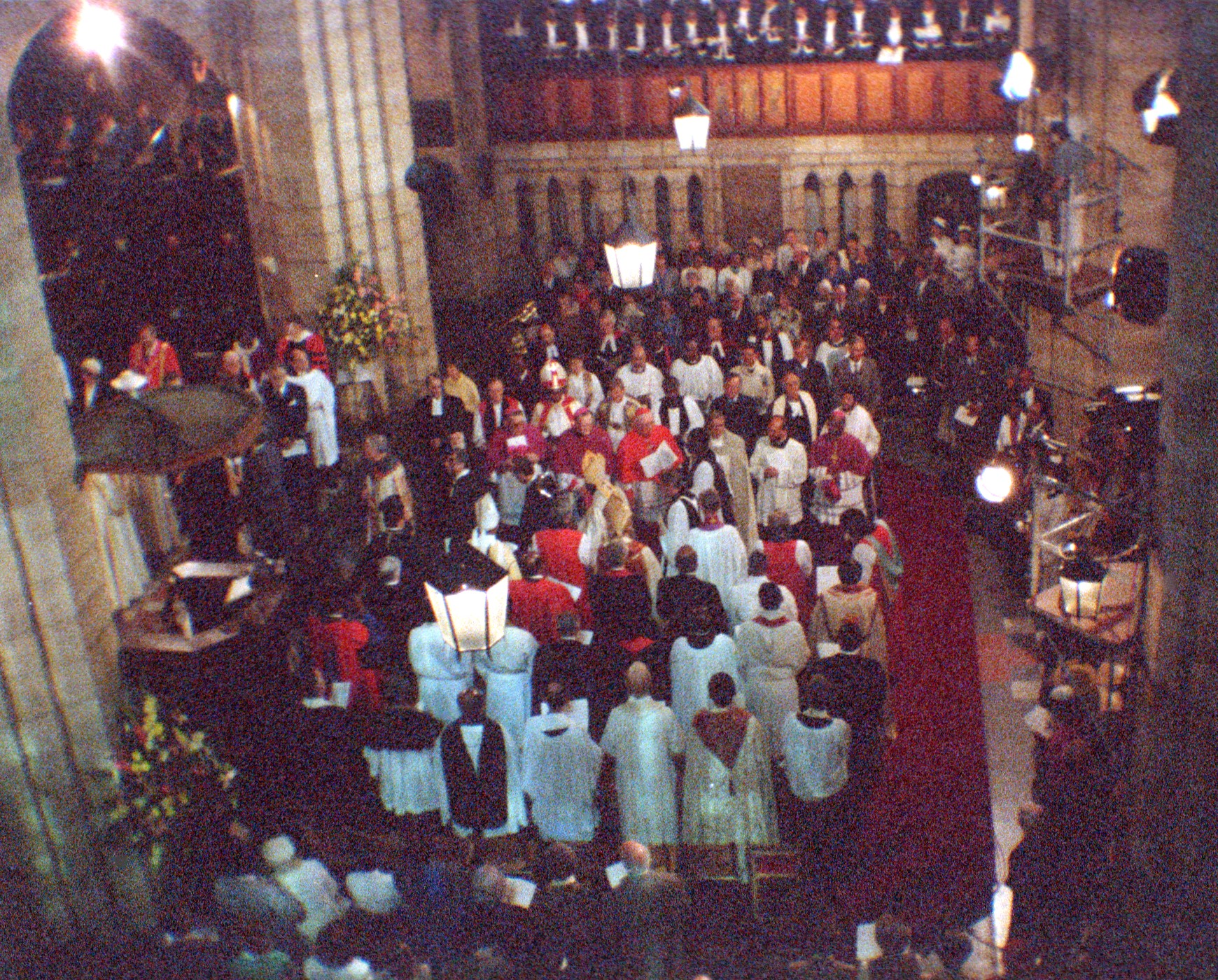 The end of the Bishops procession moving towards the choir.
The end of the Bishops procession moving towards the choir.
Scaffolding was set up in the chapels on either side of the choir, one for the press (St John’s chapel side) and the other for the 6 trumpeters (St David’s chapel side, beneath the 4 manual Hill organ). This enabled them to see over the top of the carved panels on either side of the choir and gave the press a good vantage point of the enthronement, without them being in the way. Although the film crews took responsibility for their own filming and audio, my father was involved in helping with the Cathedral sound system to ensure all the microphones used for speaking were balanced at the right volume, so was in a good position to see the actual enthronement.
Every available chair was used, plus more chairs were hired to extend the seating capacity as much as possible. The processions moved from St David’s chapel beside the vestry, past the south transcept gallery where the huge choir from Soweto was placed, along the South side aisle then along the central aisle in the nave up the red platform steps, past the choir stalls to the high altar in the Sanctuary. I recall a woman in a reclining wheelchair at the back of the South side aisle near the Lady Chapel as the procession moved slowly around the cathedral, which was packed with people, many of whom could not see much of what was going on.
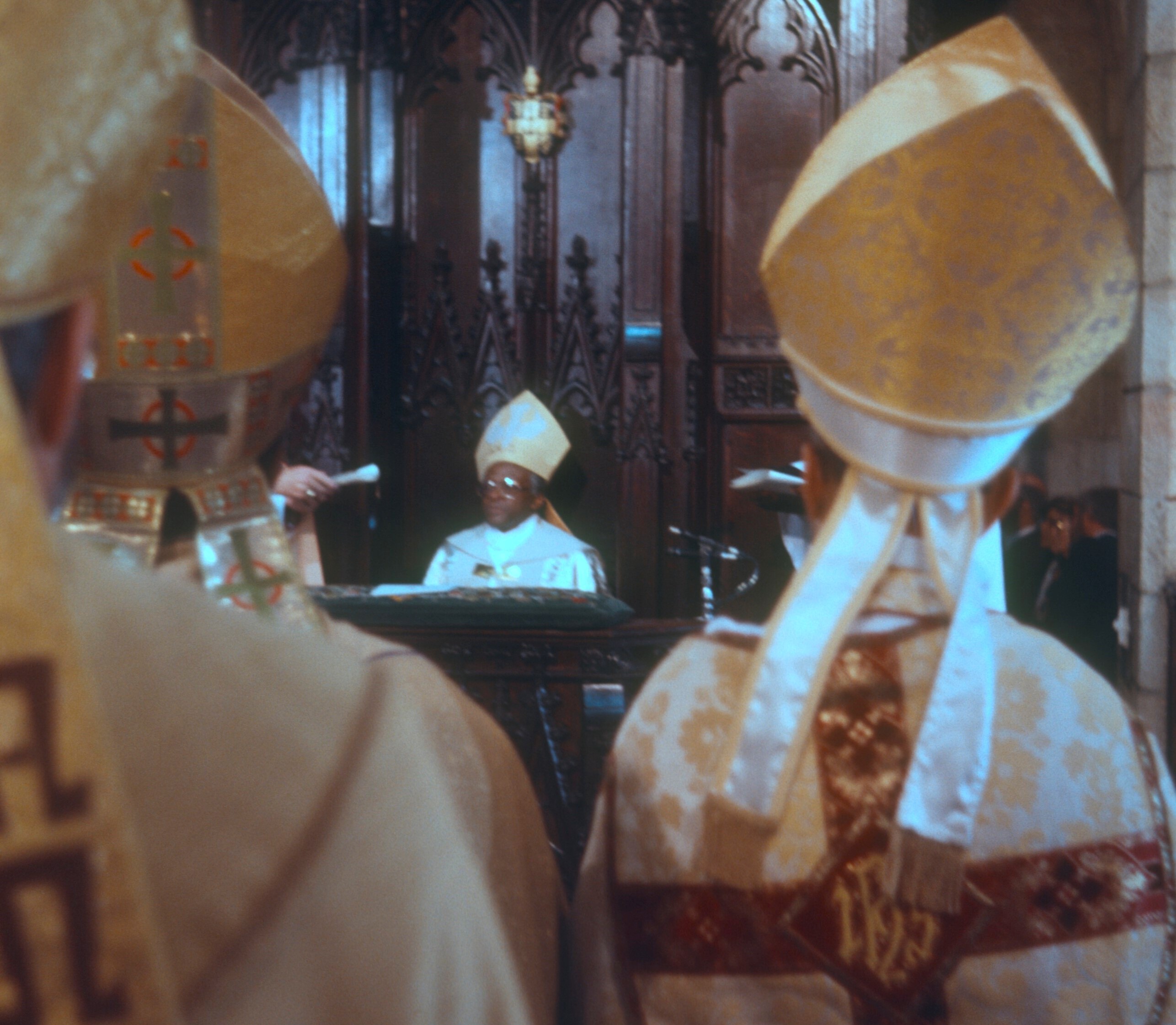 Archbishop Desmond Tutu is enthroned in St George's Cathedral by Dean of the Province and Bishop of Grahamstown, the Very Reverend Kenneth Oram.
Archbishop Desmond Tutu is enthroned in St George's Cathedral by Dean of the Province and Bishop of Grahamstown, the Very Reverend Kenneth Oram.
Our serving team was seated beside the high altar. I recall the Dean of Cape Town was also sitting in that area during the sermon and, as he sometimes did for important occasions, was wearing red socks under his robes. I didn’t get much of a view of the enthronement even though the Cathedra was not far from where I was sitting, because there were several priests standing between, but I could hear everything and had an order of service.
Archbishop Desmond Tutu’s sermon was an hour long, a local newspaper headlined ‘Dr Tutu condemns violence’ and explained that he “urged South African Christians to live as a family” and to “desire and look for the best” in others as he did for P. W. Botha, who was the president of South Africa at the time.Archbishop Desmond Tutu’s sermon was an hour long, a local newspaper headlined ‘Dr Tutu condemns violence’ and explained that he “urged South African Christians to live as a family” and to “desire and look for the best” in others as he did for P. W. Botha, who was the president of South Africa at the time. His plea for unity in the church pointed out that it wasn’t expected that every issue could be agreed upon but respecting each others’ views was important. He had told journalists that all that he said which might be construed as political stemmed from the “imperatives of the Christian gospel”.
There was plenty of traditional Anglican and Catholic music in the service, including Elgar’s Ecce sacedos magnus, Parry’s I was glad, Bach’s Jesu, joy of man’s desiring and an extract from Handel’s Judas Maccabeaeus plus some rousing hymns and the trumpet fanfare when the Archbishop was presented to the people.
The Soweto choir filled the Cathedral with pulsating, joyful and glorious African singing Ha ke Le tjee, Ke Le Mobe. John Ewington’s report for the Church Times indicates that Archbishop Desmond Tutu was swaying with the music in his throne.
The enthronement was followed that afternoon by a 3-hour outdoor Celebration Eucharist at The Cape Showground, Goodwood for 10,000 Anglicans. We attended that service, a happy affair despite the dull cool weather. The service included massed choirs, marimba bands and a rousing rendition of Nkosi Sikelei’ iAfrka, with a sermon by The Archbishop of Canterbury (who included a Xhosa proverb in his sermon about a priest only being a priest through the people) and some speeches by Dr Allan Boesack (leader of the World Alliance of Reformed Churches) and the Rev Peter Storey (former leader of the Methodist church).
Sermons and music
After his enthronement, and despite his busy schedule, +Desmond regularly preached at the Cathedral, and he was on very good terms with Fr. Ted King the Dean. As +Desmond explained later in his own tribute to the late Ted King (who died of cancer in 1998) it was a “warm and cordial relationship” (Tutu, 2007) and helped him speak truth to power in his public ministry as Archbishop of Cape Town.
His sermons were always challenging, electrifying, solemn, and fun in equal measure, he had a gift of delivering a message thoughtfully and was also very capable of poking fun at himself and others.
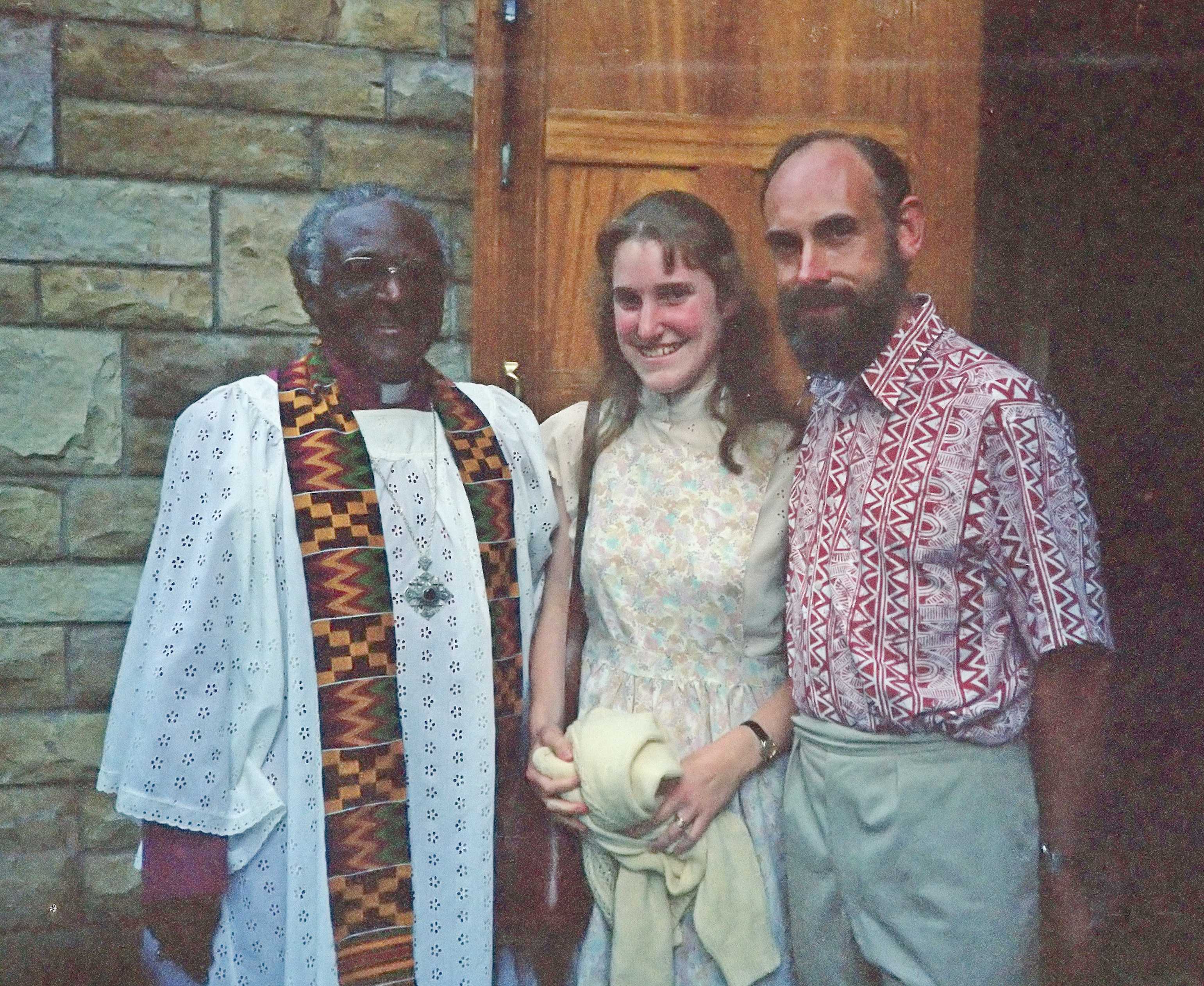 Christmas Day 1990 outside St George's Cathedral: Archbishop Desmond Tutu with Anna and John Page.
Christmas Day 1990 outside St George's Cathedral: Archbishop Desmond Tutu with Anna and John Page.
In September 1988 I left Cape Town and emigrated to England to work as an apprentice pipe organ builder. I received occasional cassette tapes from the Cathedral as my step-mother and others continued the tape ministry after my father’s sudden death in July 1988 (+Desmond sent flowers to us after my father died – the same experience retired Bishop of Natal Michael Nuttal has just talked about in the sermon at +Desmond’s funeral). In December 1990, I returned to Cape Town to get married in St George’s Cathedral, with Dean Ted King presiding at our wedding ceremony. My husband John and I returned from our honeymoon just in time for Christmas in Cape Town. On Christmas Day 1990 +Desmond preached the sermon at St George’s Cathedral and afterwards my step-mother took our photo with the Archbishop outside the Cathedral, near my mother’s memorial tree and the bell tower. This was the last time I met him, and the photo shows that he made us laugh with his sheer joyous exuberance for life, the meaning of his middle name.
Thank you Archbishop Desmond Mpilo Tutu for your wonderful example of embracing life, people and following through on your deep personal, theological convictions about equity and love.
Footnote
+ is a symbol of the cross used informally to denote a Bishop or Archbishop and is often used when they sign their names.
This article was originally published on Anna Page's personal blog. You can read the original blog post, in its entirety, here.
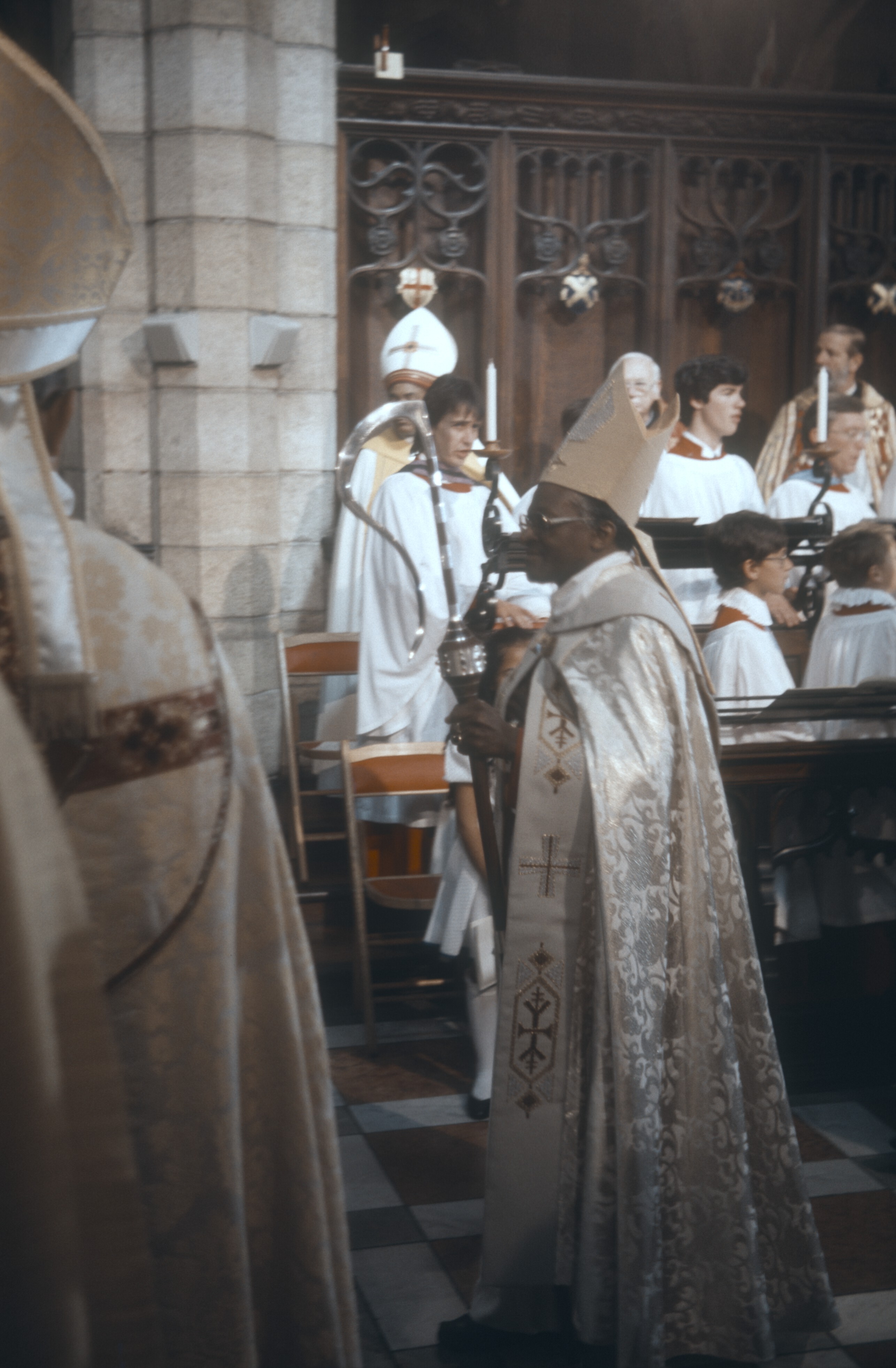
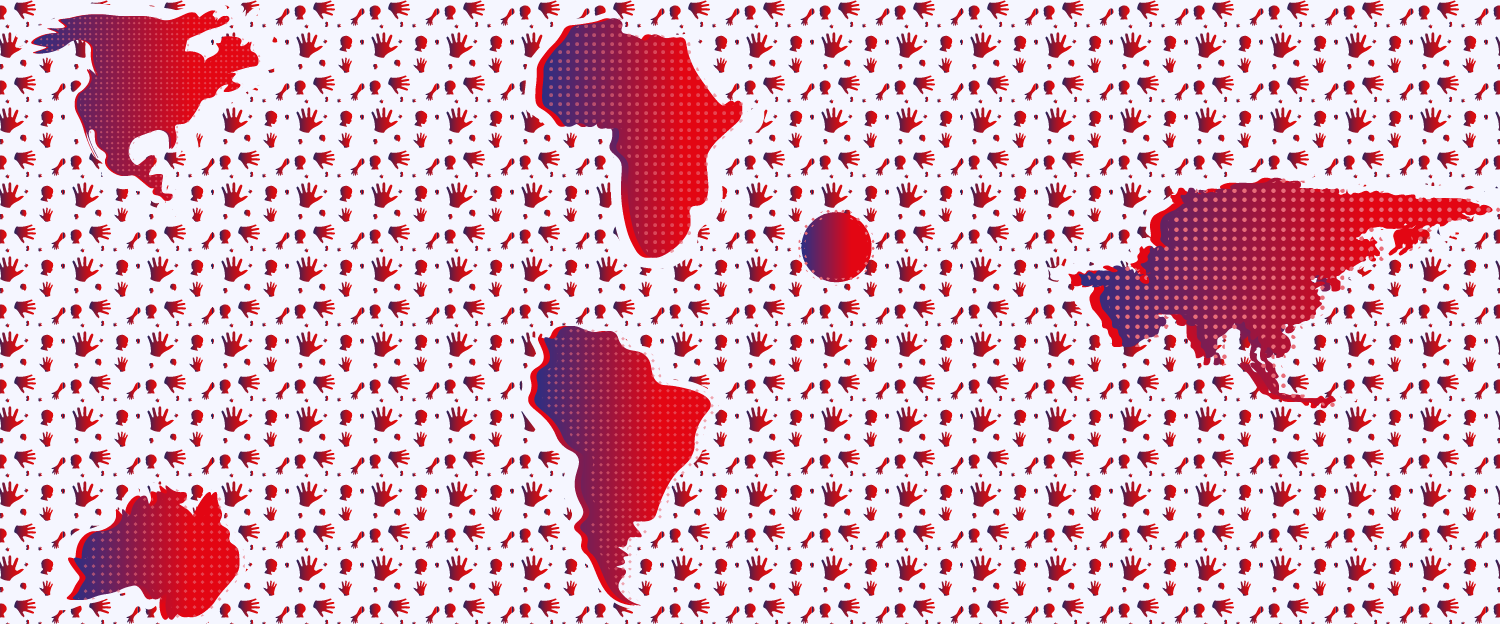


Rate and Review
Rate this article
Review this article
Log into OpenLearn to leave reviews and join in the conversation.
Article reviews